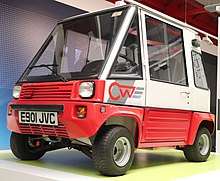Ligier JS4
The Ligier JS4 is a four-wheeled, two-seater microcar manufactured from 1980 to 1983 by Ligier, the street vehicle branch of French Formula One manufacturer Equipe Ligier. It marked a change in Ligier's priorities as they had recently ended manufacture of the Ligier JS2 sports car. It is a "Voiture sans permis", a light vehicle which did not require a driver's license and was thus popular with the elderly, the young, or with those who had lost theirs. It was first presented on 25 July 1980.[4]
| Ligier JS4 | |
|---|---|
.jpg) | |
| Overview | |
| Manufacturer | Ligier |
| Also called |
|
| Production | 1980-1983 |
| Assembly | Abrest, Vichy, France |
| Designer | |
| Body and chassis | |
| Class | Microcar |
| Body style | 3-door hatchback |
| Layout | Rear-engine, rear-wheel-drive |
| Powertrain | |
| Engine |
|
| Transmission | CVT |
| Dimensions | |
| Wheelbase | 1,350 mm (53.1 in)[3] |
| Length | 1,974 mm (77.7 in)[3] |
| Width | 1,280 mm (50.4 in)[3] |
| Height | 1,422 mm (56.0 in)[3] |
| Kerb weight | 215 kg (474 lb)[3] |
| Chronology | |
| Successor | Ligier Serie 7 |
Design
After abandoning the field of sports car manufacture Ligier briefly submanufactured tractor cabins for Renault V.I., beginning in 1978.[1][5] The JS4 was designed using one of these cabins.[2] It was a steel monococque with a short wheelbase and (comparatively) wide track.[6] It was square rigged with large, flat glass surfaces and a glazed rear door, and unusually fat tires. It had independent suspension on all four wheels, drum brakes all around, and rack-and-pinion steering.[6] The single-cylinder engine is mounted at the rear, below the luggage compartment, and produces 3.2 PS (2.4 kW) and powers the rear wheels through a continuously variable transmission.
The JS4, with its pleasant appearance and Formula One heritage, proved a strong seller. 6941 were sold in 1981, its first full year of production, a very good number for a voiturette.[2] The Ligier Formula One team used an example painted in the team colors as a pit vehicle, that example currently resides in the Lane Motor Museum in Nashville, Tennessee.[7] In late 1981 the lineup had been divided into the JS4 Standard, Luxe, and Grand Luxe, with corresponding equipment and trim. Soon, however, quality issues began to pop up. The steel body, while strong, was heavy and led to drive axles failing, and exposed a weak transmission.[1] The steel body also rusted, something that was not a problem with the mostly plastic-bodied competition.[1]
Facelifts

In 1982 the more expensive JS8 model appeared, mostly the same as the JS4 but equipped with a 125 cc engine.[8] In 1984, the JS4 was replaced by the similar JS6, which has a more rounded front, with a faux grille in black plastic. By 1985, the Motobécane engine had been replaced by 49 or 125 cc Derbi units, or a 327 cc Ducati-VM diesel.[9] The design was later developed into the 330 and 430 versions. There was also a longer truck version, called the 330 U.
See also
References
- alexrenault (2017-03-04). "Ligier JS4 (1980-1982)" (in French). Archived from the original on 2017-08-24.
- "Ligier JS4". Small Cars Club. 2017-05-20.
- "Ligier JS4, 1982". auta5p.eu.
- "Tiny Transportation". The Baltimore Sun. 1980-07-25.
- "Presentation: Ligier: The Spirit of Sport". Ligier Group. Retrieved 2017-08-23.
- Dahlan, A.B., ed. (1981-11-23). "Demam mobil ultra-mini di Perancis" [Ultra-mini-car fever in France]. Mobil & Motor (in Indonesian). Vol. 11 no. 10. PT Informedia Indonesia. p. 12. ISSN 0047-7591.
- Gitlin, Jonathan M. (2017-05-16). "Microcar madness at the Lane Motor Museum". Ars Technica. Condé Nast.
- Costa, André & Georges-Michel Fraichard, ed. (September 1982). "Salon 1983: Toutes les Voitures du Monde". l'Auto Journal (in French). Paris: Homme N°1 (14 & 15): 123. M 1117-014/015.
- Mastrostefano, Raffaele, ed. (1985). Quattroruote: Tutte le Auto del Mondo 1985 (in Italian). Milano: Editoriale Domus S.p.A. p. 1330. ISBN 88-7212-012-8.
External links
| Wikimedia Commons has media related to Ligier vehicles. |